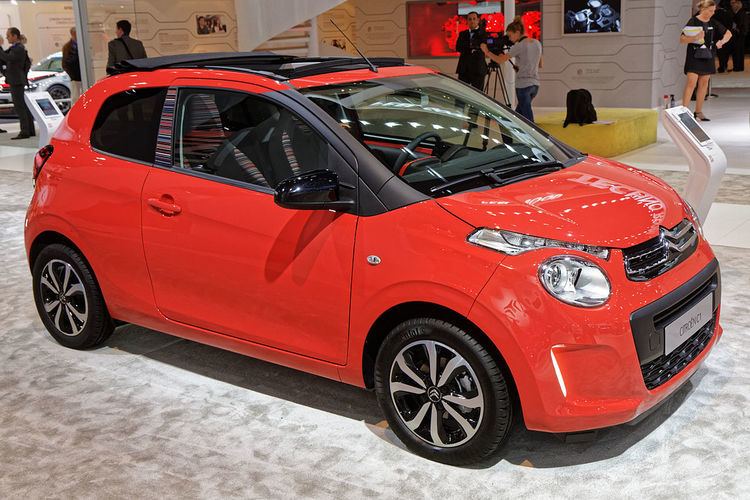Class City car (A) | Production 2005–present | |
 | ||
The Citroën C1 is a city car produced by the French manufacturer Citroën since June 2005.
Contents
- First generation 20052014
- Trim range UK
- 2009 facelift
- 2012 facelift
- Reliability
- Second generation 2014present
- References
The C1 was developed as part of the B-Zero project by PSA Peugeot Citroën in a joint-venture with Toyota. The Peugeot 107 is identical to the C1 other than the front bumper and front and rear lights, while the Toyota Aygo is slightly more differentiated but still obviously similar. All of them are built at the new facilities of the TPCA joint-venture (Toyota Peugeot Citroën Automobile) in the city of Kolín, Czech Republic. The project was presented for the first time at the 2005 Geneva Motor Show. The cars are four-seater, three-door or five-door hatchbacks measuring 3.40 metres (133.9 in) in length. The body was designed by Donato Coco.
First generation (2005–2014)
A notable feature of the five-door C1 and 107, though not the Aygo, is the large tail light cluster, which extends from the edge of the rear doors to the rear window, meaning there is no external metal "C-pillar".
The C1 is powered by a 1.0 L three-cylinder engine, which has a fuel economy of 61.4 mpg (UK gallons EU method; 4.6 L/100 km EU method; ca 43.4 mpg US with US method). A 1.4 L four-cylinder HDI diesel engine which has a fuel economy of 68.9 mpg (UK gallons EU method; 4.1 L/100 km EU method; ca 48.8 mpg US with US method) is also available.
According to the German magazine Der Spiegel, the C1 is the production car with the second-best fuel economy both among petrol engines (after the Toyota Prius) and among diesel engines (after the Smart ForTwo).
In January 2010, PSA Peugeot Citroën announced that it is recalling "under 100,000 units" of the C1 and the Peugeot 107, following the worldwide recall by Toyota for a faulty sticking accelerator pedal – in which the Aygo is affected. Under certain circumstances, the pedal can stick in a partially depressed position, or return slowly to the off position.
Trim range (UK)
Designer Franco Sbarro created an extreme C1, called the C1 GT, a design concept that follows the same theme of his previous Xsara Picasso Concept. The extreme bodywork feature very wide wheels and gullwing doors, alongside a modified 1.6L 125 PS (92 kW; 123 hp) engine from the C2VTR and C4 WRC rallycar brakes. It's said to have reached over 130 mph (210 km/h).
In Portugal a commercial van version called the Entreprise is offered, equipped with the 1.4L diesel engine and available only in the 3-door body, for urban use. Its 107 sibling also offers an identical version.
In the United Kingdom, the Electric Car Corporation has been selling an electric car based on the C1, called the Citroën C1 ev'ie since 30 April 2009. Its list price on that date was £16,850 (US$$24,989), "double the cost of the petrol version".
2009 facelift
In January 2009, the Citroen C1 was facelifted at the same time as the Peugeot 107 and Toyota Aygo.
The new C1 features a new front bumper incorporating a new grille, in-keeping with Citroen's family look. Trim levels were also refreshed – basic Vibe models became 'VT', and Rhythm became 'VTR'. Seat fabrics and ventilation controls were also changed, and all models received colour-coded front bumpers and new wheel trims.
A special-edition 'Splash' was available at launch, though this was a strictly limited edition. This was based on the basic 'VT'. However, it featured Air Conditioning, CD player, electric front windows. The Splash model was available in Electra Blue or Lipizan White. Electra Blue came with white door mirrors, whilst the Lipizan White came with glossy black door mirrors.
Engines remained the same, but tweaks mean the 1.0 petrol now emits just 106 g/km of CO2 and reportedly able to achieve 72 mpg‑imp (3.9 L/100 km; 60 mpg‑US) fuel consumption. The 1.4 HDi diesel engine remains unchanged, again only available in the higher specification. Three new colours were also added to the line-up.
2012 facelift
Citroen made a further facelift in 2012. Changes included;
Two new trims were added to the facelift C1 range – Platinum and Edition, both coming with alloy wheels, leather steering wheel and gear stick as standard. VTR+ became the entry level when these were introduced.
Reliability
Breakdown statistics reported by the German Automobile Club in May 2010 placed the Citroën C1 (which the data grouped with the Peugeot 107 and Toyota Aygo) at the top of the sub-small car class in respect of the low break-down rates achieved for cars aged between 1 and 4 years. Class laggards were the Chevrolet Matiz (0–3 year old cars) and the Smart Fortwo (4–5 year old cars).
Second generation (2014–present)
At the 2014 Geneva Motor Show, Citroen revealed the new-look, completely redesigned version of the C1 which is built at a factory of the Toyota Peugeot Citroen Automobile Czech (TPCA) in a joint venture between the Peugeot 108 and Toyota Aygo.
